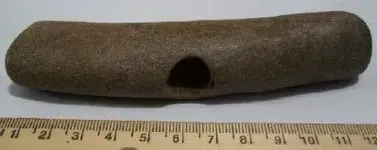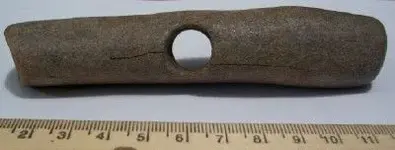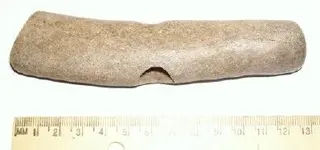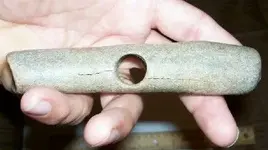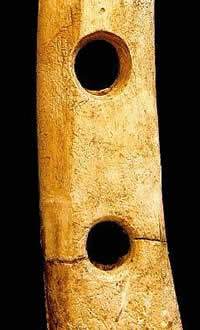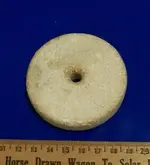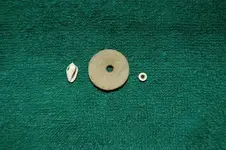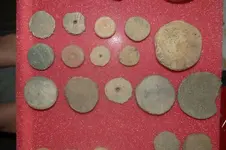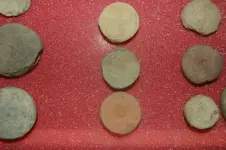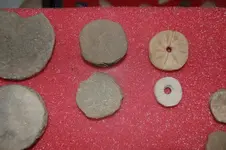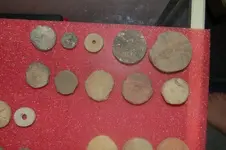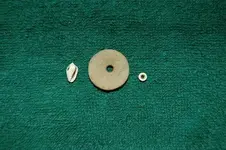Hey Dorkfish, I appreciate your information and opinion on my son's antler tool, whatever it may be. I will say that it could be any number of things besides a weight, including a shaft straitener, but I would go towards some kind of handle for a tool, before I went shaft straitener. Wouldn't you agree ,though, that the item with two drilled holes which you pointed out, could also be any number of things besides an "arrow wrench". Could have been a child's whirling toy since it has two holes. Could have easily been called a gorget. Shaft Straightener is, after all , just what one archeologist or small group decided to call this particular artifact.
.
It is my opinion that "shaft straightener" has been a pretty generic term for any grooved or drilled item that some professional archeologist cannot or would not otherwise identify. The only items I have ever seen that I thought had a chance of being shaft straighteners were grooved stones. Most of those in reality were only used to sharpen bone for needles or awls. NOne of them would be capable of straightening any shafts, but could perhaps knock off a few burrs if rubbed along its length.
My thinking is that if mr. Native American started out with a crooked stick to make a shaft for spear or arrow, he was already in trouble. I would like to hear some solid theory behind the shaft-straighteners and how they worked or how they were used. There is no hard evidence of such that I know of. If there is a cave painting of such or maybe a late 19th century photograph I would love to see it. Pretty much all theory. I think the process goes something like ," we decided this is what this item is, but we have no real basis for this decision, other than we don't really know what it is and shaft straightener sounds pretty good plus it's been used to describe other drilled items." I Would really like to hear how they theorize such a tool could make a crooked stick, straighten out, and stay straight. I have seen guys use bannerstones and spearthrowers, but not one of these shaft wrenches.
Not saying that your assessment of this artifact is wrong, I appreciate the response and I am always willing to learn. I think you may just be misinformed or are putting a little too much faith in what "professionals" say. I am only saying that I will never agree with something just because some professional archeologist said it. No matter how many more years they went to college than I or how much experience they have in the field, they can be wrong, and have been proven so. The only thing professional archeologists have proven to me is their intense dislike for amateur archeologists. I know several old time diggers, who the professionals refer to as looters, who know more about native americans than most professionals will ever know. I think professionals use the term "shaft straightener" more as a cop-out to avoid trying to truly identify all the drilled and grooved tools which were used for countless other chores, toys, and decoration. It's just an easy out for them. Most may never be identified and are doomed to remain whatever a particular professional chooses to call them. A shame but, Probably impossible to identify them all I would think.
Thanks again for your response, and if you have access to some harder evidence or better documentation of native americans and shaft straighteners I would enjoy seeing it . I think there is much more solid theory backing spearthrowers and weights whether this be one or not. Learning new stuff is one thing I love about treasure hunting. I have been wrong many times, but have also learned that just because no one has seen one yet, or the biggest collector in the country doesn't own one, or its not in a book or on the net, doesn't mean it don't exist.
I have no problem admitting I could be wrong, and no offense is intended towards you. I just like a little more discussion, and a few more opinions before drawing such a definite final conclusion.
Very Respectfully,
Dan



